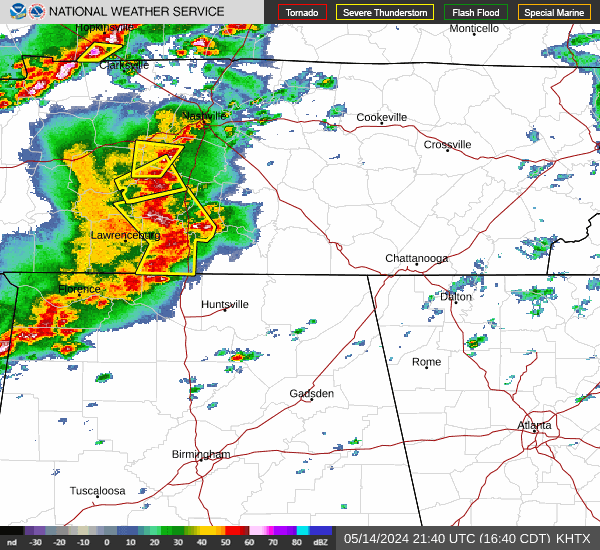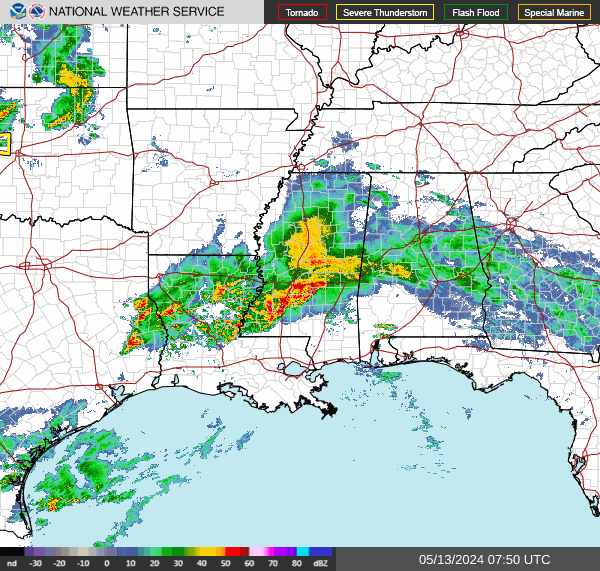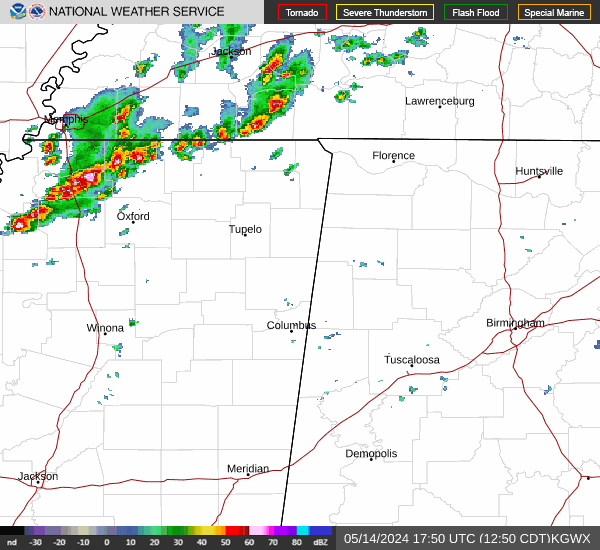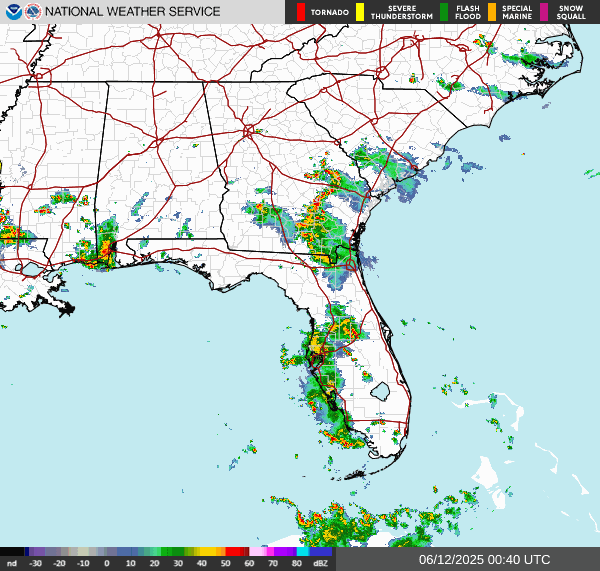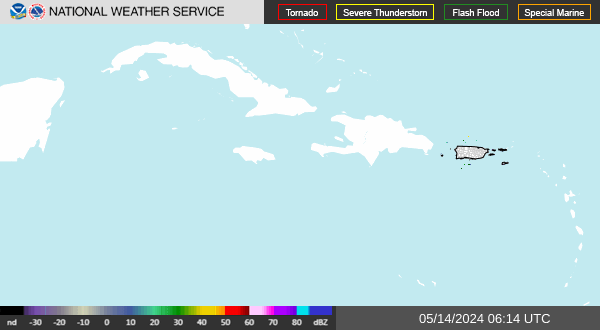North Alabama and Southern Middle Tennessee mainly have severe weather season during the Spring months of March, April, and May.
But we also have a secondary peak in the cool season, usually during the month of November. This is when we are trying to change to Winter. Usually the cold fronts that hit this time of year only bring some rain and gusty winds. But if the air gets warm and muggy enough, sometimes that same wind energy can produce powerful thunderstorms and even tornadoes.
This essay is a condensed version of something I wrote back in October, because really, the time to prepare for severe weather is when the weather is still calm, like it is right now.
Let's go over some definitions.
A severe thunderstorm is a thunderstorm that produces winds of at least 50 knots (so 58 miles per hour) or hail at least an inch in diameter (about the size of a quarter). These thunderstorms are thought to be an immediate threat to life and property.
For the technical definition of a tornado and the official government guidelines, check out this page. (Here is a link to tornado safety info in Spanish, and also the Spanish version of preparedness in general. It is challenging enough to communicate weather information sometimes when everyone's language is the same, all the technical jargon that comes with meteorology, so I really appreciate the people who have made the efforts to translate this into literally another language.)
But if you've lived around here any length of time, you know what a tornado is. It does have to be in contact with the ground to be a tornado. If it's up in the air, it is still a funnel cloud. And you're lucky if you can see a funnel around here.
So it's more important to pay attention to severe weather alerts around here. We do not have flat lands like they do out in the Great Plains and Midwest, and a lot of our tornadoes are wrapped in rain, coming out of "high-precipitation supercells". You can't really wait around to see or hear them coming, so you have to respect the warnings when you get them.
The best way to do that is with a NOAA Weather Radio, one with battery backup in case of a power failure. You can get one online or at most stores for about $30. I've had the same one for well over ten years. So the investment is definitely worthwhile. As an alternative or extra layer of awareness, some people might prefer a service like WeatherCall or similar cell phone app. WeatherCall has been around a long time, and I consider it to be reliable.
Programming a weather radio is not as daunting as it first appears. Here is an excellent video from Taylor Sarallo in case any of you get a headache about it like I did the first time I bought a digital weather radio
Don't rely on outdoor warning sirens, as they play a very limited role in letting people know something is going on. If you don't want to use a weather radio or good phone service, you can still enable Wireless Emergency Alerts on your cell phone and/or stay tuned to a reliable radio station that will cut in for severe weather.
A Tornado Watch means that conditions are favorable for the development of severe thunderstorms, that are capable of producing tornadoes, in and close to the watch area. People in those areas need to stay alert for rapidly changing weather conditions, and listen for later statements, or possible warnings.
A Tornado Warning means that a tornado is believed to be developing or already occurring, based on radar data and/or a reliable report, in the warned area. Warnings are usually only issued for a small part of a county at a time now, drawn as a polygon on the map. People within that warning polygon should shelter first and gather more information later.
A Severe Thunderstorm Watch means that conditions are favorable for severe thunderstorms to develop, but without tornadoes being likely, more of a threat for damaging straight-line winds and/or large hail.
A Severe Thunderstorm Warning means that the storm is believed to be producing damaging winds or hail. Which can still be dangerous.
And if the environment already favors tornadoes, then a tornado could develop from a severe thunderstorm before a tornado warning officially comes out. That has happened many times over the years, to the point that if someone is under a tornado watch and a severe thunderstorm warning at the same time, I'd rather know they're already going to a safe place, instead of waiting to see if a tornado warning is required later. The infamous tornado that hit Huntsville on November 15th, 1989 actually touched down during a Severe Thunderstorm Warning, which then had to be quickly upgraded to a Tornado Warning. And such things have happened many times over the years. That's an example people will remember though.
Any time you hear or see the term Particularly Dangerous Situation attached to a watch or a warning, that is exactly what it sounds like.
Most people these days do not have access to a storm shelter. But nine times out of ten, a person can survive a tornado by doing the right things in a site-built house or other strong building, doesn't have to have a basement.
If you live in a mobile home (or manufactured home, trailer) or another weak structure (like an apartment on the top floor is another example), then you might want to look into public storm shelters. Or it is even better if you have a family member or friend with a sturdy house (or if you are very lucky, a storm shelter or basement) who will let you stay with them when the weather is dangerous.
If you want to call your county's Emergency Management Agency to ask about public shelters, then please try to do it before a severe weather event gets underway, at a time the weather is calm, and they are not busy. Here is the directory for Alabama and for Tennessee.
And it's important to familiarize yourself with where you are on a map, what county you live in, and what counties border you. Excellent maps of Alabama and Tennessee can be found at www.geology.com.
Assuming you have a sturdy house or other strong building to shelter in, the guidelines are:
* Stay away from windows.
* Get to the lowest floor.
* Get into a small room, such as a bathroom, closet, or hallway - where the walls are less likely to collapse under the winds, even if they are tornado winds.
* Make that safe space as near the center of the building as you can - as many walls between you and that storm outside as possible.
* If you have time, shield your body in some way from falling or flying debris. Especially protect your head.
And if you do that, you are very likely to survive, and actually are pretty likely to survive without any serious injury. It's especially important to protect your head, whether you use a pillow or blankets, or whether you can go hardcore with something like a bike or football helmet. While it's not as critical, it is also a good idea to wear some shoes, your sturdiest pair, just in case you were to come out to broken glass or other tornado debris after a storm. And if you have something that will make noise, like an air horn, sometimes that will help emergency workers find you faster if the storm has piled up a lot of debris. I don't mean to scare anyone by running through some of the worst-case scenarios, but it's good to think about them ahead of time, just in case. Once in a while people do get trapped by tornado debris and have to be rescued. And sometimes people do step on things like broken glass or even, much more dangerous, a downed power line, after a really bad storm. If you have some idea of how you'd handle these situations ahead of time, then if you have the bad luck to face one, chances are, you'll be all right.
If you do have the option to get into an actual storm shelter before a tornado hits, then of course you should use that. But the odds are in your favor sheltering above-ground in a well-built house. The last place you ever want to shelter is in a mobile home. Usually you'll have a better chance of surviving lying in a low spot outside, such as an unflooded culvert or ditch, than if you stayed in a mobile home.
Another place you don't want to get stuck, if you can do anything about it, is in a car. There is an old myth about getting up under a bridge, but it really is a myth. Opinions vary on whether a car is safer than getting into a ditch or other low spot outside, but during a tornado, I favor the low spot outside. While admitting that either one is a last resort.
A great meteorologist named Tim Troutman used to always say that any route you drive regularly, you should think of three or four places you could pull over, in the event of a tornado warning, and take safe shelter inside. Even if it's something as simple as a gas station, that is a lot safer than staying in a vehicle. And some service stations or restaurants are open all night. If any truckers think I'm keeping them in mind, you might have a point there.
This information is more than you are likely to ever need to stay safe from severe weather. But sometimes the extra pointers can come in handy.
The basic idea is to be in a sturdy house or other strong building, and to get as low down as you can, and as near the center as you can, staying well away from any windows and shielding your body, especially your head.
If you have any questions or suggestions to improve this safety essay, you can always send me an e-mail.
